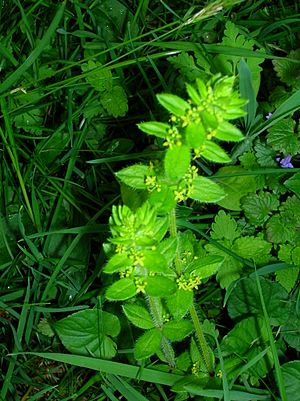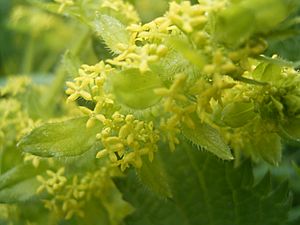Crosswort facts for kids
Quick facts for kids crosswortsmooth bedstraw |
|
|---|---|
 |
|
| Cruciata laevipes | |
| Scientific classification | |
| Synonyms | |
|
Crosswort (scientific name: Cruciata laevipes) is a type of flowering plant. It belongs to the Rubiaceae family. People also call it smooth bedstraw. In Gaelic, it's known as Luc na croise. The name laevipes comes from Latin and means "smooth stalk," which describes its stem.
What Crosswort Looks Like
This plant is a perennial, meaning it lives for more than two years. It grows in a sprawling way, spreading out along the ground. Crosswort can reach a height of about 15 to 70 centimeters (6 to 28 inches).
It spreads using its seeds and special stems called stolons. These stolons grow along the ground and can form new plants. Crosswort has yellow flowers, which is unusual for plants in its group. Its flowers are hermaphrodite, meaning they have both male and female parts.
The flowers on the inside of the plant are male and fall off quickly. The outer flowers have both male and female parts and are the ones that produce fruit. These flowers have a sweet smell, like honey.
Crosswort leaves grow in groups of four, called whorls. But only two of these are true leaves. The other two are called stipules, which are small, leaf-like parts at the base of the leaf stalk.
This plant works with a type of fungus called arbuscular mycorrhiza. This fungus grows into the roots of the plant, helping it get nutrients from the soil. In the United Kingdom, crosswort flowers from April to June. Bees and flies help to pollinate its flowers.
Where Crosswort Grows
Cruciata laevipes is found in many parts of Europe. You can also find it in northern Turkey, Iran, the Caucasus region, and the western Himalayas. It has also started growing naturally in Ontario County in New York State, even though it wasn't originally from there.
Crosswort likes to grow in places like meadows, along the sides of roads, near rivers, in bushy areas, and in open woodlands. It usually prefers soils that drain well and contain a lot of calcium, known as calcareous soils.
How Crosswort Was Used
Today, crosswort is not used much in herbal medicine. However, a long time ago, people thought it could help with certain health problems. It was once suggested as a way to treat ruptures, rheumatism (pain in joints and muscles), and dropsy (when the body holds too much water).
An old English medical book called Bald's Leechbook even suggested crosswort as a cure for headaches.
See also
 In Spanish: Cruciata laevipes para niños
In Spanish: Cruciata laevipes para niños


